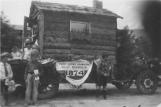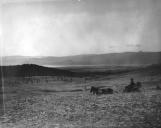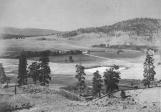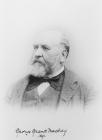14
Portrait of Frederick BrentCirca 1890s
Vernon, British Columbia
 Credits:
Credits:Kelowna Public Archives #98
15
The first several years were a struggle for the priests and settlers. In 1862, W.G. Cox referred to the owners of the five cultivated farms as paupers, without enough money between them to construct a flour mill even though the wheat crops were looking promising. However, by the mid-1860's the settlers and the Mission were beginning to benefit from their hard toil. A few more settlers came in the following years but settlement was slow, in part due to the lack of a suitable road to reach outside markets.16
Lequime's post office, store and hotel in the Okanagan MissionCirca 1880s
Okanagan Mission, British Columbia
 Credits:
Credits:Kelowna Public Archives #117
17
In 1861, a school was established by the Oblates of Mary Immaculate (OMI) priests for the settler's children at the mission site. The language spoken was French.In 1874, William Smithson donated an acre of land to the government for the first public school in the Okanagan Valley. The Okanagan School, located in William Smithson's former log home, was opened in December 1875. The government had bought the log building for $750, so that it could be re-used as a school. (The school was located close to the present day School Board Offices on Underhill Road). The school district included what is now known as Kelowna, Okanagan Mission, Mission Creek and Benvoulin areas. It also served a larger area, as students came from other parts of the valley and boarded with locals. Angus McKenzie was the first teacher and taught there until 1878. The first school trustees were: William Smithson, Frederick Brent and Joseph Christien.
In 1906, the log 1875 school was torn down and a new one-room school was built. In July 1929, the school's name changed to Benvoulin School. The name was changed to avoid confusion, as the district where the school was located, had been known as Benvoulin ever since MacKay had named it. In 1931, the school doubled in size with the addition of a second classroom.
18
First Okanagan School float in the Kelowna Regatta ParadeCirca 1920s
Kelowna, British Columbia
 Credits:
Credits:Kelowna Public Archives #366
19
In the early years there were few roads, only narrow trails in most parts of the valley. Late in 1875 the provincial government called for tenders to build a wagon road from the Catholic Mission in the south to O'Keefe's Ranch at the northern end of Okanagan Lake. This new road, named the Okanagan and Mission Valley Wagon Road, covered approximately 38 miles. The completion of this first road provided increased opportunities for the inhabitants of the Mission Valley. It allowed ranchers to deliver grain, flour or vegetables to an outside market and to bring merchandise, machinery, furniture and other necessities to the settlement in order to make life more comfortable. ("Ogopogo's Vigil", F.M. Buckland, 1979, p. 54)20
Old wagon road looking towards Mission ValleyCirca 1905
Okanagan Mission Valley, British Columbia
 Credits:
Credits:Kelowna Public Archives #9006
21
After struggling for several years, life began to get better for the priests and settlers with the start of the early agricultural settlement that developed around Father Pandosy's Mission. Most of these early settlers were subsistence farmers, whose world was defined by their farms. Their crops included wheat, barley, potatoes and even tobacco. Some settlers also ran herds of cattle on the grassy hillsides and sold their stock to miners passing through the area. Transportation was a formidable challenge to sell beyond the local market and most farmers had to rely on those living nearby or passing through to sustain them.The North Okanagan had the large acreages (pre-empted) for raising cattle, but these soon became over-grazed. The winter of 1879-80 was unusually severe and thousands of cattle starved to death. Ranchers realized they needed to grow hay to feed their cattle. The valley's bottomlands were soon transformed from range to hayfields.
When the long-awaited construction of the CPR got underway in early 1880, demand for beef was very strong with five thousand workers to feed. To meet demand the O'Keefe and Coldstream ranches in the North Okanagan and the Lequime, Knox and Postill ranches in the Mission Valley, grew to thousands of acres.
22
Portrait of Alfred PostillCirca 1890s
Okanagan Mission Valley, British Columbia
 Credits:
Credits:Kelowna Public Archives #107
23
View of the Postill Ranch on Duck LakeCirca 1910
Okanagan Mission Valley, British Columbia
 Credits:
Credits:Kelowna Public Archives #4186
24
The Postill family arrived in the Okanagan in 1872. Alfred (son of Edward and Mary Postill) and his brothers William and Edward Jr. bought a ranch in the northern part of the Mission Valley - in what is now known as the airport/Ellison area. Alfred ran the business and William looked after the cattle on the five thousand acres with an additional two thousand acres for grazing located a few miles away. They had the largest herd of cattle in the Mission Valley and also bred some very fine horses. Sheep and pigs were soon added. The ranch also included a sawmill left behind by a previous owner. The family was the first to plant alfalfa in the area.Alfred Postill was one of the first in the Mission Valley to plant an apple orchard in 1874. "Soon every farmer had his little plot containing two or three varieties of bearing fruit trees." ("A Fruitful Century: The British Columbia Fruit Growers' Association 1889-1989", p.4) Any surplus fruit might be sold to neighbours, but was largely grown for personal consumption. Later on when commercial fruit growing was being considered, the Okanagan's early small orchards were used as examples that the Okanagan was an area in which that it would be possible to grow fruit commercially.
On February 1, 1889 a meeting was held at the Vancouver Board of Trade to "discuss the propriety of forming a Fruit Growers' Association for this Province." ("A Fruitful Century: The British Columbia Fruit Growers' Association 1889-1989", D. Dendy, 1990, p.9) George Grant (G.G.) MacKay, a well-known and successful land promoter from Vancouver, also attended this meeting. The new agricultural organization, British Columbia Fruit Growers' Association (B.C.F.G.A.) was formed at this meeting. Board of Directors included: G.G. MacKay, who was elected the B.C.F.G.A. director for Vancouver city and vicinity; Alfred Postill representing the Okanagan and A.L. Fortune from the Spallumcheen district. Only eight of the twenty-nine directors were present at the meeting, the others, including Postill and Fortune appear to have been selected 'in absentia'. Even though G.G. MacKay and Alfred Postill likely did not meet at this time, their mutual interest in fruit growing would soon bring them together in the Okanagan Valley.
"Alfred Postill's advocacy of his valley's fruit-growing potential likely caught the attention of MacKay. It was a fortuitous encounter, as G.G, MaKay would soon play a very significant role in the transformation of the Okanagan." ("The Kelowna Story: An Okanagan History", p.37)
25
Portrait of George Grant MacKay3 February 1891
Okanagan Valley, British Columbia
 Credits:
Credits:Vernon Museum Public Archives #12044